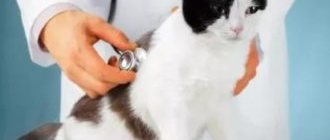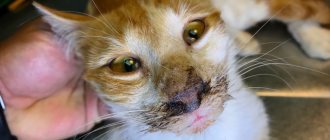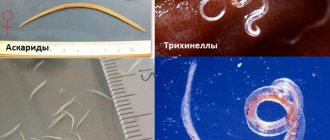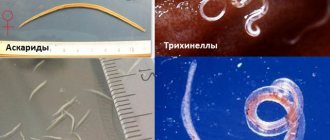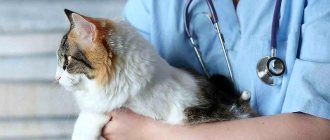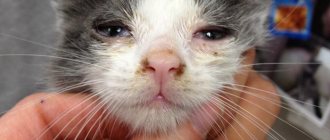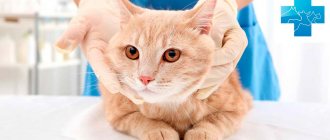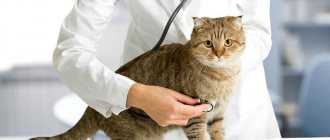Feline infectious peritonitis and its causative agent
For cats, the following diseases caused by coronavirus are common pathologies:
Accumulation of exudate in the abdominal cavity.
- FECV – or feline coronavirus enteritis;
- FIPV is actually infectious peritonitis.
Both of these pathologies are severe, dangerous and are close strains of the same virus. In the practice of veterinarians at the RosVet VC, it is noted that such animals arrive in a very serious condition, mainly due to a lack of understanding of the owners. They believe that the cat “simply feels unwell” and will soon go away on its own. But infectious peritonitis without treatment is fatal in 100% of cases.
What systems can the virus affect?
Radiographic examination of the cat revealed signs of effusion in both the abdominal and thoracic cavities.
Penetrating into the cat’s body, the virus spreads throughout the body, resulting in a generalized infection.
Its damaging effect extends to:
- on the circulatory and lymphatic system;
- on the intestines;
- on internal organs - liver, pancreas and spleen;
- on the lungs, kidneys.
The heart, nervous system, visual organs and brain suffer.
From FECV to FIPV
FECV affects the cells of the small intestine, kittens aged 1-3 months are susceptible, they develop diarrhea, then vomiting. With timely treatment, the animal recovers, but remains a virus carrier for a month. Therefore, such a kitten is isolated from other cats (quarantine).
FECV is transmitted through feces and is easily transmitted if multiple domestic cats share the same litter box. To avoid this, you need to wash your home and trays with disinfectants; the virus quickly dies.
In the wild or nurseries, the virus spreads quickly if basic sanitary and hygienic rules for keeping animals are not followed. The virus persists in feces for up to 7 weeks.
FECV is considered a common disease, but not all breeders go to veterinary clinics for it. Enteric coronavirus is characterized by mild symptoms and often self-recovery, so the disease does not attract the attention it deserves.
According to research, relatively mild FECV can mutate into a severe form of FIPV, infectious peritonitis virus. As a result of mutation, it gains the ability to quickly spread throughout tissues and organs, causing IPC. According to statistics from the RosVet Center, a similar mutation of FECV to FIPV occurs in 10-12% of cases. This is why it is necessary to treat coronavirus enteritis.
How is FIP Diagnosed?
Diagnosis of FIP is carried out on the basis of a comprehensive examination, the following methods are used:
- Anamnesis collection. The data gives an idea of the conditions of detention, past diseases, and contacts with virus carriers.
- Inspection. Allows you to identify disturbances in the functioning of the heart, enlarged liver, lymph nodes, ascites.
- X-ray and ultrasound. Show changes in internal organs, the presence of fluid and granulomatous formations.
- Testing. It is carried out using immunofluorescence analysis (IFA). The test detects antibodies to the virus in the blood and effusion. Reverse CPR detects the presence of coronavirus in the feces, saliva or blood of a sick animal.
- Exudate analysis. Based on the condition of the fluid and chemical properties, the disease can be excluded or diagnosed.
Carrying out laparoscopy and taking a biopsy is the most reliable method for diagnosing peritonitis and proves the presence of pathological changes in tissues.
Routes of spread and transmission of the FIPV virus
The infectious peritonitis virus is not transmitted from cat to cat, that is, keeping a healthy and sick animal nearby is not dangerous. But it is better not to do this with a large gathering of pets, since there is always a possibility that some cat has an intestinal coronavirus and it is this individual that is the carrier of the FECV virus, which mutates.
Facts about FIPV. The virus can manifest itself when:
- the cat’s genetic predisposition to the disease;
- after stress, if the pet has already caught an intestinal virus;
- immunosuppression (when a mutation is provoked by another virus that has entered the body).
Infectious peritonitis is widespread everywhere; there are no narrow areas where the disease does not occur at all. Most cats have antibodies against coronavirus, especially among wild flocks or in large catteries. The peak of the disease with coronavirus enteritis, with a possible transition to infectious peritonitis, occurs in animals from 4 weeks to 3 years. As adults, cats rarely get sick.
Diagnosis and treatment
Diagnosing infectious peritonitis in cats is extremely difficult, and there are still too many unknowns about this issue. For example, a blood test can detect the presence of antibodies, which appear as a reaction of the body to coronavirus. But this analysis does not allow us to distinguish between coronavirus enteritis and peritonitis. Moreover, in some cases, antibodies are not produced in the presence of FIP.
Peritonitis is diagnosed based primarily on symptoms, x-rays, and PCR testing of effusion fluid, if present.
There is currently no cure for infectious peritonitis in cats. Unfortunately, most affected cats die. Antibiotics are ineffective against peritonitis, immunomodulators do not bring effective improvement, anti-inflammatory drugs only delay the inevitable. A doctor can only prescribe treatment that will somewhat prolong the life of a sick pet and alleviate symptoms.
Let us note that only very recently new vaccines and medications are beginning to appear, which, we hope, will make it possible to cope with peritonitis in the near future.
Some cats are generally immune to this virus, but scientists have not yet been able to understand their protective mechanism.
What are they doing at the RosVet Exhibition Center?
When a cat is admitted with suspected infectious peritonitis, the veterinary clinic doctors:
- collect anamnesis (age, presence of the animal in a crowd of its own kind, stress preceding the onset of symptoms);
- note characteristic clinical symptoms. With effusion peritonitis, this is an accumulation of fluid in the abdominal/thoracic cavity and a high temperature, up to 39.5. With dry peritonitis - fever for more than 4 days, anorexia, weight loss, enlarged lymph nodes (mesenteric), eye damage, jaundice and neurological symptoms.
There are no specific symptoms of infectious peritonitis; it all depends on which organ is affected. The target cell of the virus is chosen not by any monocyte, but by its individual populations, which have a specific tropism for the endothelium of serous venules, omentums, pleural membrane, lining of the brain and choroid of the eyeball.
For laboratory diagnostics:
- take a general clinical and biochemical blood test;
- examine the effusion fluid;
- do PCR diagnostics;
- use immunofluorescent method;
- carry out serological studies (antibodies to coronavirus).
Conclusions from observations:
- treatment is not effective;
- a clinically healthy cat with antibodies to FCoV, not the drier form of FIP;
- The absence of antibodies in a pet with diarrhea rules out the presence of FCoV, which is not considered to be the cause of diarrhea.
If your cat (kitten) has diarrhea and is vomiting, but it seems that the condition is more or less stable, you should definitely show your pet to a veterinarian. Even if FECV is relatively easily tolerated, it can cause the development of feline viral peritonitis, which leads to the death of the animal. Call! Doctors at the RosVet VC are available around the clock and are always ready to help.
PATHOGENESIS
The occurrence of FIP is associated with a mutation of the feline coronavirus (FCoV). When infected with coronavirus, virus replication occurs in the epithelial cells of the respiratory tract and intestines. The initial stage of feline coronavirus is usually asymptomatic, but in rare cases it manifests as mild to moderate enteritis. The mutation of coronavirus into viral peritonitis most often occurs after a stressful situation in a cat’s life, accompanied by a decrease in the body’s immune status.
By infecting the intestinal epithelium, feline coronavirus FCoV passes through the intestinal mucosal barrier, mutates into infectious peritonitis (FIP) and replicates in monocytes/macrophages, gaining access to the blood. Further, IPC, accumulating in the walls of blood vessels, increases their permeability, this leads to the removal of proteins from the blood vessels and the formation of effusion fluid. Thus, the “wet” or exudative form of viral peritonitis develops. Typically, the exudative form appears within 3–6 weeks after a stressful situation in the cat’s life.
The “dry” non-exudative form of viral peritonitis passes without changing the permeability of the walls of blood vessels and is characterized by the formation of granulomas in the internal organs.
The serological ELISA test for determining antibodies to coronavirus infection in cats, used by the Chance Bio laboratory, also proves the relationship between coronavirus (FCoV) and feline infectious peritonitis (FIP). About 80% of cats with FIP peritonitis had a high titer of antibodies to coronavirus >1:160, the remaining 20% had a titer in the range of 1:20-1:160, which also confirms feline coronavirus disease (FCoV).
ROUTES OF INFECTION AND DISTRIBUTION
The current situation of the active spread of coronavirus gastroenteritis is frightening, and this will ultimately lead to an increase in patients with viral peritonitis. It is easy to imagine a picture of a bright future; early diagnosis of coronavirus and timely treatment if necessary are necessary. The main routes of transmission of the virus:
- nutritional (via contaminated feces)
- vertical (from infected cat to kittens)
- sexual (when mating with a virus carrier)
Feline coronavirus (FCoV) is more common in kennels where animals are kept in groups.
About 60% of purebred cats are seropositive by ELISA test systems and are virus carriers. 7% of domestic cats with coronavirus develop infectious peritonitis (FIP). In cats that live in groups, viral peritonitis (FIP) is more common.
CLINICAL SIGNS
Clinical signs of exudative “wet” peritonitis:
- presence of ascites and/or effusion fluid
- with effusion into the pleural cavity - respiratory distress
- fever
- the cat is lethargic, loss of appetite leads to anorexia
- the pathological process of IPC leads to dysfunction of other abdominal organs, most often renal failure, changes in the functioning of the liver and pancreas.
- The mesenteric lymph nodes and liver are enlarged and palpable
Clinical signs of non-exudative “dry” peritonitis:
- lack of appetite, anorexia
- damage to the central nervous system is more common: vestibular disorders, seizures, urinary incontinence, changes in behavior
- ocular nystagmus due to the development of hydrocephalus
- The mesenteric lymph nodes and liver are enlarged and palpable
- formation of pyogranulomas in the kidneys
- change in the size of the colon wall
Can a vaccine protect a cat?
There is a vaccine against the non-mutated form of feline coronavirus. It protects pets from other diseases caused by the same pathogen - enteritis and infection. But if the pet has already been in contact with an infectious relative, vaccination loses its effectiveness.
The vaccine is administered in the form of drops into the kitten’s nose; vaccination time is 3.5-5 months.
If the mother of the kittens was infected, then vaccination is useless; the kittens themselves have become carriers of the infection, have been ill or are at risk of a severe form of the disease.
The vaccine is ineffective against peritonitis; vaccinated cats get it just as much as unvaccinated cats. It is not yet possible to develop a remedy that would help avoid the fatal cat disease. We can only hope for prevention in healthy people and timely diagnosis in sick people.
Neonatal peritonitis of kittens
The virus can cause fading of newborn kittens and their sudden death.
The baby is observed:
- weight loss
- weakness
- exhaustion
- general deterioration of condition
- labored breathing
- cyanosis of the skin and mucous membranes
- death within a few hours from circulatory collapse
The infection is especially dangerous for nurseries, where entire litters of kittens die from viral peritonitis. When the first clinical signs appear, you should seek help from a veterinarian as soon as possible.
Bibliography
1. Ozherelkov S.V., Kalinina E.S., Kozhevnikova T.N., Sanin A.V., Timofeeva T.Yu., Timofeev A.V., Stevenson D.R. Experimental study of the phenomenon of antibody-dependent enhancement of the infectivity of the tick-borne encephalitis virus in vitro // JMEI, 2008; 6:39-43. 2. Rakhmanina N.A. Clinical and epizootological features and diagnosis of infectious peritonitis in cats: abstract. diss. ...cand. vet. Sci. - M., 2007. 3. Sanin A.V. FIP - is there light at the end of the tunnel? // Russian Veterinary Journal. Small domestic and wild animals, 2011; 4:17-20. 4. Furman I.M., Vasiliev I.K., Narovlyansky A.N., Pronin A.V., Sanin A.V. The use of drugs based on plant polyprenols for various forms of feline infectious peritonitis // Russian Veterinary Journal. Small domestic and wild animals, 2010; 3:42-43. 5. German A. Between a rock and a hard place: diagnosis and treatment of FIP // Abstr. ISFM Feline Symposium 2010, pre-BSAVA Congress. 6. Hartmann K, Ritz S. Treatment of cats with feline infectious peritonitis // Vet Immunol. Immunopathol., 2008; 15; 123(1-2): 172–175. 7. Kipar A., Meli ML, Failing K., Euler T., Gomes-Keller MA, Schwartz D., Lutz H., Reinacher M. Natural feline coronavirus infection: differences in cytokine patterns in association with the outcome of infection / / Vet Immunol Immunopathol., 2006; 15; 112(3-4): 141–55. 8. Legendre AM, Bartges JW Effect of Polyprenyl Immunostimulant on the survival times of three cats with the dry form of feline infectious peritonitis // Feline Med Surg., 2009; 11(8): 624–626. 9. Pedersen NC A review of feline infectious peritonitis virus infection: 1963—2008 // Journal of Feline Medicine and Surgery, 2009; 11: 225–258. 10. Takano T., Katada Y., Moritoh S., Ogasawara M., Satoh K., Satoh R., Tanabe M., Hohdatsu T. Analysis of the mechanism of antibody-dependent enhancement of feline infectious peritonitis virus infection: aminopeptidase N is not important and a process of acidification of the endosome is necessary // J Gen Virol., 2008; 89(Pt 4): 1025–1029.
Prevention of infection
To prevent the occurrence and spread of the disease, you should avoid places with large concentrations of animals, carry out vaccinations in a timely manner and observe sanitary and hygienic standards for keeping mammals.
You should protect your pet from psychological discomfort that reduces the body’s natural resistance, feed it well, treat it in a timely manner against blood-sucking parasites and helminths, and also contact a veterinarian if your pet is unwell.
It is necessary to regularly check the cattery and all cats in the house. Because serological testing is often inaccurate, animals suspected of having FIP are isolated and observed. When a new pet arrives, quarantine is required for 2-3 weeks and testing for the presence of coronavirus.
